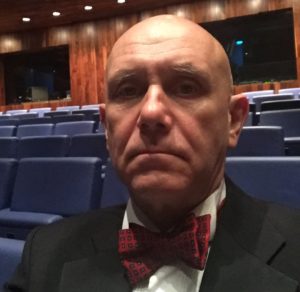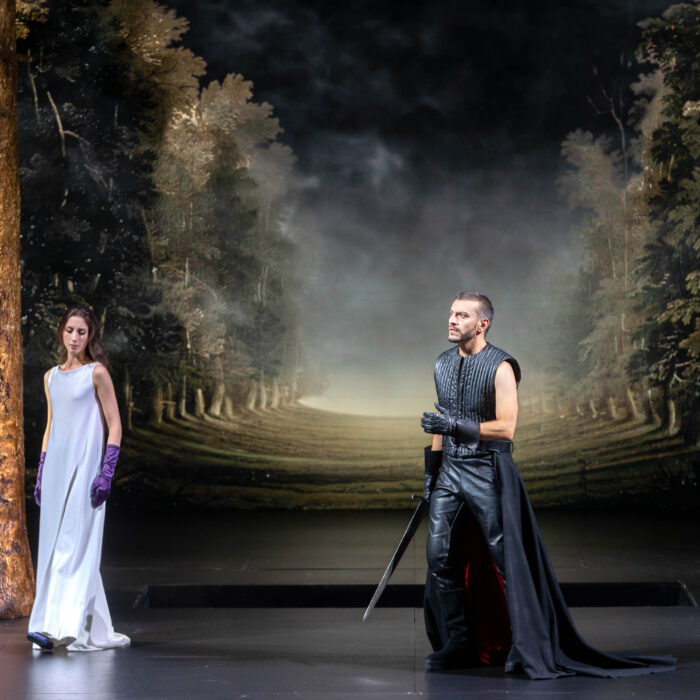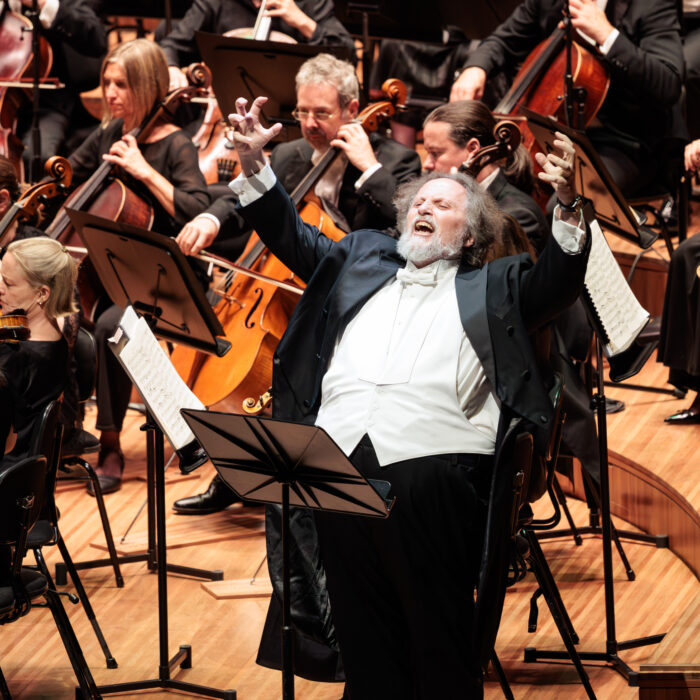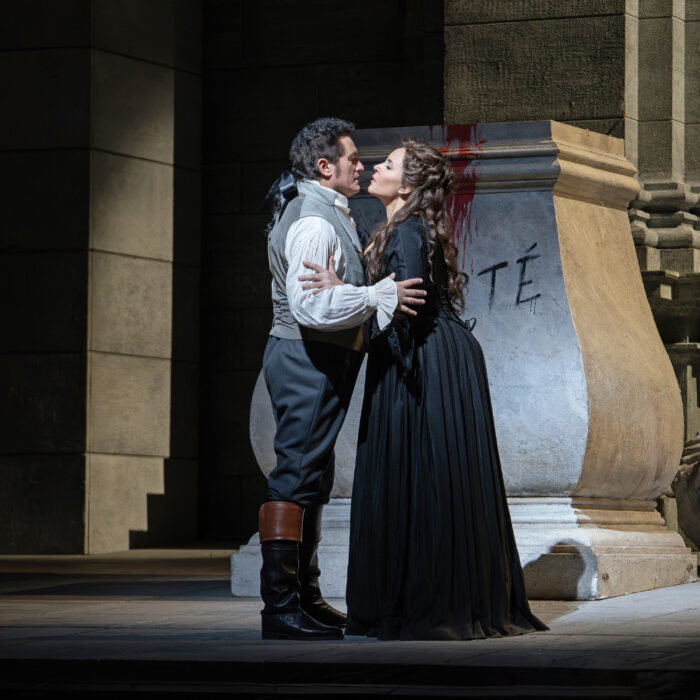
Blackwater Valley Opera Festival 2025 Review: A Midsummer Night’s Dream
Ami Hewitt Stands Out In The Role Of Tytania
By Alan Neilson(Photo: Frances Marshall)
Even the rain that poured down for almost the entire performance did little to dampen the audience’s enthusiasm for the Blackwater Valley Opera Festival’s headline event, Benjamin Britten’s “A Midsummer Night’s Dream,” that took place in Lismore Castle grounds. Although the seating area was protected by a canopy, it could not stop the chilled air from blowing in, yet the audience remained oblivious so taken up was it by the magic of the unfolding drama. The protective covering also saved the orchestra from a good soaking. The singers, however, although partially protected, were not so fortunate, especially if they were required to spend any time on the back half of the stage, which lay open to the elements. The singers, nevertheless, rose to the occasion and successfully played out their roles in what was a fabulous production. However, one can only imagine how uncomfortable it must have been for Ami Hewitt, playing Tytania, who had to lie down on a soft bed, positioned towards the back, for a considerable time.
The libretto was adapted by Britten and Peter Pears from Shakespeare’s original text, to which they stayed faithful, apart from one or two minor alterations. Act one, however, was cut completely so that the opera starts with Oberon and Tytania arguing in the woods outside Athens. The characters consist of three distinct types: fairies, simple rustic folk, and the lovers, each with their own distinctive sound world. Although enmeshed in their own personal dramas, they also interact with each other, usually thanks to the mischievous behavior of the prankster, Puck, and often with amusing results. It was the rustics’ play, “Pyramus and Thisbe,” in Act three, however, that really had the audience laughing out loud, in which its amateurish presentation helped keep the comedy alive.
The director Patrick Mason decided on a clear, straightforward presentation of the narrative without any attempt to construct a weird and way-out interpretation or to uncover subsidiary motivations or themes. Each character was expertly drawn to provide them with an easily recognizable, sharply defined personality that allowed their behavior to sit comfortably within the quick-moving plot and thus made it simple to follow. The scenes were neatly constructed to bring out their dramatic energy, always with an eye on their comedic potential.
The stage was positioned in a courtyard and backed on to an old farm building, which gave the staging a natural and pleasing backdrop. Paul Keogan, responsible for the staging and lighting, took a minimalist approach, yet it worked very well. The only prop of note was a large four-poster bed, positioned in its centre. White neon lights in the form of frames were used to suggest exits and entrances at its sides. The singers also occasionally departed from the rear of the stage. With its fairly large cast and children’s chorus, there was always a lot of coming and going, yet it was all well-ordered; all movements were carefully choreographed so that there was never any sense of overcrowding or chaos.
Catherine Fay, the costume designer, produced an array of outfits that related specifically to the three separate groups of characters. The group of rustics were dressed in slightly old-fashioned working-cum-casual clothes, such as corduroy trousers, checked shirts and dungarees, but when they were performing the play, they wore dark suits, which, with a quick change, easily turned them into a troupe of Morris dancers, allowing them to engage in an amusing dance. While the four lovers could have walked out of a 1950s movie, the characters from the fairy world could have stepped out of the pages of a history book: Tytania, with more than just a slight resemblance to Queen Elizabeth I, looked spectacular; Oberon, in a fancy doublet and hose, could easily have passed for one of her dukes; and the children’s choir were dressed to look like her pages. There were also the two minor roles of the king, Theseus, and his bride, Hippolyta, who were suitably attired as early 19th century monarchs.
Amy Hewitt’s Detailed Singing
Soprano Ami Hewitt gave a dominant performance as Tytania, both vocally and visually. She came across as forceful and serious by comparison to her husband, Oberon. Her singing was clear, precise and expressively detailed, and she moved her voice sensitively in response to her changing moods and the nuances of the drama. There was also a pleasing agility to the voice that allowed her, when needed, to dance lightly across the line and delight with short, bright and beautifully fashioned passages of coloratura. Her scene with Bottom, while certainly amusing, did not, however, quite capture the depth of Tytania’s infatuation.
Countertenor Iestyn Morris was a suitably impulsive Oberon yet kept a calm demeanor throughout. His singing had a beautiful clarity, elegance and refinement, while his gentle, detailed embellishments and graceful phrasing possessed a captivating quality. On the negative side, his projection was a little weak, and while he could still be clearly heard, it created an imbalance in the musical texture.
There was nothing sprightly about Barry McGovern in the spoken role of Puck. Rather than a fun-loving, mischievous and quick-witted imp who revels in the upset and chaos he causes, McGovern’s Puck came across as cynical, even world-weary, and seemed to take little joy in his pranks. Instead of bonding with the audience with knowing asides, fashioned to provoke a laugh, he stood aloof and seemed content to comment and philosophize; an impression heightened by his black tunic that made him appear like a counsellor. On the positive side, he spoke clearly and energetically. However, the role really required a greater degree of physical engagement.
The children’s chorus, which played a group of young fairies, was an energetic bunch that engaged enthusiastically, confidently and wholeheartedly with their roles.
The Four Lovers cannot Control their Emotions
Tenor Peter O’Reilly created a convincing portrait of Lysander, in which he successfully imbued his voice with an earnest passionate desire for his lover, Hermia. After succumbing to Puck’s potion, he falls for Helena, and his fervent protestations of love actually increased.
After being jilted by Lysander, mezzo-soprano Sarah Richmond as Hermia reacted with a perfectly measured, slightly over-the-top response, in which her physical and vocal posturing had everyone laughing. It was a testament to her finely tuned awareness and excellent stagecraft that it was both amusing and believable simultaneously.
Together, Richmond and O’Reilly displayed a good understanding with each other, which made their relationship, when deeply in love or at loggerheads, fully believable.
Baritone Gregory Feldmann was a single-minded, passionate Demetrius; he had no interest in Helena and was determined to get Hermia. He possesses a secure, firm voice with a pleasing lyricism and expressivity that he used intelligently to fashion his character. His outbursts of anger could be deliberately quite amusing.
Soprano Amy Ní Fhearraigh, playing the role of the lovestruck Helena, gave free rein to her character’s passions, successfully moulding her voice to reveal her swirling emotions, which at times bordered on the hysterical, particularly when she believed that she was being mocked by Demetrius and Lysander as they both pursued her with romantic intentions.
Her relationship with Feldmann was also thoughtfully developed to bring out their turbulent relationship; their quarrels could be quite fierce, with both of their voices rising erratically with increasing excitement.
An Absurd Production of ‘Pyramus and Thisbe’
The group of rustics produced highly amusing performances, enthusiastically playing up their roles to bring out their full comedic potential and kept the audience thoroughly entertained. Unsurprisingly, given the nature and scope of the role, it was bass-baritone Dominic Veilleux as Bottom who really attracted the sympathy and attention of the audience. Displaying a confident, strong presence, he convincingly paraded around the stage, acting and fooling around like a donkey, and had the whole audience laughing along. It was all completely over-the-top. His clearly articulated, securely founded singing, which exhibited a natural, attractive lyricism, also impressed.
Bass-baritone Jakob Mahase portrayed his character, Quince, the director of the play, as a good-natured, steady individual who struggled to impose his authority on the group of actors but generally remained in good spirits, which was reflected perfectly in his vocal presentation, which was secure and reliable with a pleasing depth that added ballast to the character.
Tenor Conor Prendiville can be relied upon to produce convincing acting performances, and his essaying of the role of Flute was no exception. A weak-willed character, he is bullied into playing the role of the woman, Thisbe, in their play and turned out to be a complete natural with a brilliantly funny and expressively outrageous portrayal, in which his mimicking of a female was ridiculously absurd, yet very impressive.
Bass Rory Dunne produced a secure and confidently sung performance in the role of Snug, in which his clear articulation, firm projection and ability to fashion the line made him ideal for the part of the Lion in the play, to which he brought more than a little hilarity.
Tenor Seán Tester, performing the role of Snout, a character that does little to impose himself, gave a solid, nicely sung rendition. It was in the play, in which he was cast in the ludicrous role of the Wall, costumed as a red-brick variety, that really made him stand out and had some of the work’s funniest lines.
Moonshine, another equally preposterous role in ‘Pyramus and Thisbe,’ was allocated to the character of Starveling, played by baritone Massimo Modoni, who successfully brought out the comedy and sang with a pleasing lyricism.
The play was performed to celebrate the marriage of the king, Theseus, played by baritone Christopher Cull, to Hippolyte, parted by mezzo-soprano Gemma Ní Bhriain. Apart from watching the play, they had relatively little to do. Both maintained a regal demeanor and produced confident, clearly sung performances.
David Brophy, conducting the Irish Chamber Orchestra, elicited a detailed, clearly defined and balanced performance that was sensitive to the drama while carefully revealing the score’s fascinating textural qualities.
There was little that one could reasonably object to about the performance. Visually, its simple staging sat well against the fabulous background of the castle yard while allowing Fay’s splendid costumes to stand out, and the stage was expertly used to ensure the drama had the necessary space in which to develop. Mason’s direction captured the spirit of the narrative and played up the comedy reasonably well. There were one or two areas in which improvements could have been made, not least in the portrayal of Puck, who just did not have the necessary sense of chaotic fun, but otherwise it was a well-conceived interpretation. Musically, it was excellent; both singers and the orchestra produced fine performances, in which Ami Hewitt’s Tytania stood out.



